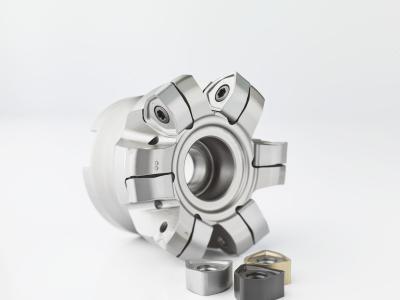
Seco Tools LLC has expanded its solutions for difficult-to-machine materials with the introduction of the High Feed 6—the latest addition to the High Feed series of indexable-insert milling cutters. This new cutter features a design
created specifically to boost material removal rates and handle high chip loads, resulting in substantial productivity increases and exceptional tool life, according to the company.
The High Feed 6 milling cutter shows strong performance in all kinds of steels, especially mold and die steels, making it particularly valuable to that industry segment. In addition, the new tool can tackle a variety of difficult-to-machine materials from stainless steel to heat-resistant superalloys. The tool performs equally well in all high-feed applications, including facemilling, slotting, contouring, plunging and helical interpolation. The large-diameter cutter bodies are capable of 0.070" (1.8 mm) axial depths of cut and feature double-sided inserts with six cutting edges for effective material removal and low operating costs.
High Feed 6 inserts mount at low lead angles to direct machining forces up into the machine tool spindle rather than radially against the side of the tool. As such, the tool experiences less vibration and provides long, predictable performance. The flexible High Feed 6 is available in 13 metric cutters with outer diameters from 50 mm to 160 mm and nine imperial cutters ranging from 2 to 4 inches in diameter, as well as both normal and close-pitch versions. Inserts are available in three cutting geometries. A variety of advanced grade and coating options are available.
Contact Details
Related Glossary Terms
- facemilling
facemilling
Form of milling that produces a flat surface generally at right angles to the rotating axis of a cutter having teeth or inserts both on its periphery and on its end face.
- feed
feed
Rate of change of position of the tool as a whole, relative to the workpiece while cutting.
- gang cutting ( milling)
gang cutting ( milling)
Machining with several cutters mounted on a single arbor, generally for simultaneous cutting.
- interpolation
interpolation
Process of generating a sufficient number of positioning commands for the servomotors driving the machine tool so the path of the tool closely approximates the ideal path. See CNC, computer numerical control; NC, numerical control.
- milling
milling
Machining operation in which metal or other material is removed by applying power to a rotating cutter. In vertical milling, the cutting tool is mounted vertically on the spindle. In horizontal milling, the cutting tool is mounted horizontally, either directly on the spindle or on an arbor. Horizontal milling is further broken down into conventional milling, where the cutter rotates opposite the direction of feed, or “up” into the workpiece; and climb milling, where the cutter rotates in the direction of feed, or “down” into the workpiece. Milling operations include plane or surface milling, endmilling, facemilling, angle milling, form milling and profiling.
- milling cutter
milling cutter
Loosely, any milling tool. Horizontal cutters take the form of plain milling cutters, plain spiral-tooth cutters, helical cutters, side-milling cutters, staggered-tooth side-milling cutters, facemilling cutters, angular cutters, double-angle cutters, convex and concave form-milling cutters, straddle-sprocket cutters, spur-gear cutters, corner-rounding cutters and slitting saws. Vertical cutters use shank-mounted cutting tools, including endmills, T-slot cutters, Woodruff keyseat cutters and dovetail cutters; these may also be used on horizontal mills. See milling.
- slotting
slotting
Machining, normally milling, that creates slots, grooves and similar recesses in workpieces, including T-slots and dovetails.
- superalloys
superalloys
Tough, difficult-to-machine alloys; includes Hastelloy, Inconel and Monel. Many are nickel-base metals.

